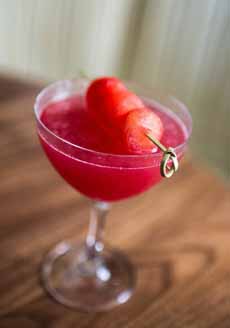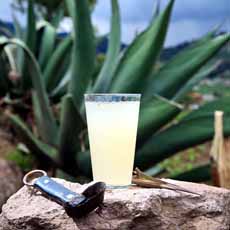
[1] The two special tequila glasses: caballito and Margarita (photo © El Jimador).

[2] A tequila-watermelon cocktail. The recipe is below (photo courtesy Milagro Tequila).

[3] After harvesting, piñas are roasted in a stone oven (photo © Casa Noble Tequila).

[4] Pulque: what the Aztecs drank before the conquistadors taught them how to distill (photo © Mexico News Network).
|
|
July 24th is National Tequila Day. How about some tequila trivia?
THE AGAVE PLANT
The Blue Weber agave plants used to make tequila are pollinated by bats. They flower only once.
While the agave plant looks like a cactus, it is a succulent in the lily family.
The leaves of agave are so sharp that they are used as cutting instruments.
A blue agave plant matures in 6-12 years and weighs 90 to 150 pounds. The piña itself (photo #3) weighs from 25 to 50 pounds.
The piña is the part of the plant used to make tequila, and gets its name because it looks like a pineapple (piña in Spanish). It grows underground. It looks like a pineapple, so is called a pia.
The person who harvests the piña is called a jimador (HEE-ma-dor), which derives from the verb gemir, to groan with effort.
THE TEQUILA
The nectar of the piña is called pulque (PULL-kay, photo #4). The Aztecs fermented the sap from the leaves of the maguey agave. It was drunk by people of rank during religious ceremonies.
Pulque remained popular until the late 19th century. Its sales declined in favor of beer, which was brewed by European immigrants.
The conquistadors, who arrived in 1519, taught the Aztecs how to distill agave into a spirit, now known as tequila.
There are four legally authorized expressions (categories) of tequila: blanco, reposado, añejo and extra añejo. Laws dictate the minimum and maximum aging period for each. Here are details.
For marketing purposes, some premium producers have created “hybrid” tequilas with new names, e.g., barrel select reserve blanco; or have created extra-extra aged tequila marketed which may be called, e.g. 5 years aged tequila, or El Magnifico. These are names bestowed by the distillery, not by law.
The longer it ages, the more flavors it develops and the darker it gets. Blancos, which are clear, can be aged for a few weeks for complexity, but so briefly that they don’t take on color.
The worm in the bottle (which is the larva of a moth) is not placed into tequila bottles, but into some mezcal bottles. These are cheaper, “tourist souvenir” mezcals, not quality brands.
DRINKING TEQUILA
The taste of tequila comes partially from its aging time in white oak barrels, but also from the volcanic soil of the Jalisco region, which imparts a spicy, earthy quality.
The traditional way to drink tequila is from a tall, narrow shot glass called a caballito (photo #1), which means little horse. Another name for the glass is tequilito, little tequila shots.
When drinking shots, the wedge of lemon or lime provided is to refresh the palate between drinks.
FLore has it that tequila shots cause fewer hangovers than cocktails with sugar, but this isn’t so. The alcohol hangover is caused by the dehydration effect from the alcohol itself.
TEQUILA SALES
Tequila was first imported to the U.S. in 1873. It remained a niche product until Mexican restaurants began to open up outside of California and the Southwest, in the 1960s.
The United States is the largest tequila-consuming market (yes, even more than Mexico).
Almost half of the tequila is drunk by women (which may owe thanks to regular and frozen Margaritas).
The Margarita is the number one cocktail in the U.S., per The Spirits Business.
OK, you’ve earned your drink. Happy National Tequila Day!
|





